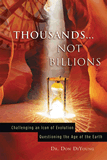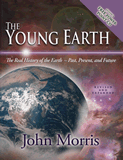Decay and Age: Rocks
Newswise: “Scientists Read Rocks’ History With Unprecedented Precision” http://www.newswise.com/articles/view/528010/
This article starts off by revealing a commonly forgotten fact of geologic dating: “Assigning dates to the events in the life of a rock […] has long challenged geologists, as the events themselves can confound evidence of the past.” Although many laypeople think of radiometric dating as unquestionably reliable, the truth is, many of the “ages” such dating methods suggest are contentious and contradictory. And, of course, no ages are actually given, but rather merely isotope levels. (For more on this topic, see our Radiometric Dating and recent RATE research.)
“But now,” the article asserts, “University of Massachusetts Amherst scientists are able to pin dates to geologic processes with unprecedented precision.” How?
If the rates of decay have rapidly decreased in recent millennia, such age estimations would be in significant error.
[R]esearchers discovered that nature has a version of an airplane’s black box, in the form of a little-known mineral called monazite. [… M]onazite contains uranium and thorium—elements that decay to lead over a predictable length of time—allowing scientists to read the ratios of these elements like a clock.
In reality, the clock analogy is less accurate than the {% get_urls 125 alt="candle analogy" %}. Although scientists may claim that such elements as uranium and thorium decay “over a predictable length of time,” they cannot prove that these decay rates have never changed; after all, such decay rates have only been recorded by scientists within the last century. Nor can they know for sure the original amount or ratio of these elements. If the rates of decay have rapidly decreased in recent millennia, such age estimations would be in significant error. Recent data from the RATE project shows the opposite—that rapid decay took place in the past. It is fascinating how this ground-breaking research has been ignored for the most part by those that believe in long ages. Yet long-age scientists accept the constancy of decay rates because of their a priori acceptance of uniformitarianism: that present observations are the key to understanding the past. This is incompatible with the Bible, which gives us the starting point (and ending point!) of the history of the universe.
In other words, radiometric dates are ultimately based on assumptions—unbiblical assumptions.
Remember, if you see a news story that might merit some attention, let us know about it! (Note: if the story originates from the Associated Press, Fox News, MSNBC, the New York Times, or another major national media outlet, we will most likely have already heard about it.) And thanks to all of our readers who have submitted great news tips to us.
(Please note that links will take you directly to the source. Answers in Genesis is not responsible for content on the websites to which we refer. For more information, please see our Privacy Policy.)
Recommended Resources

Answers in Genesis is an apologetics ministry, dedicated to helping Christians defend their faith and proclaim the good news of Jesus Christ.
- Customer Service 800.778.3390
- Available Monday–Friday | 9 AM–5 PM ET
- © 2025 Answers in Genesis






